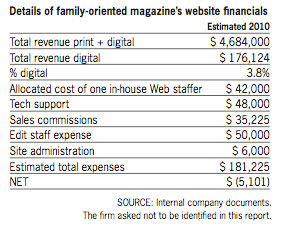Introduction
4. Media commentator Alan Mutter addressed this in a post, “Non-profits can’t possibly save the news,” Reflections of a Newsosaur, March 30, 2010, http://bit.ly/dMp86C. He calculated the news media would need an endowment of $88 billion to produce enough revenue to support current models.
Chapter One
10. Remarks made at Borrell Associates Local Online Advertising Conference, March 3, 2011.
12. A study of local online media has this to say: “Content is king, but not the content most people think. News and information sites do indeed generate revenue, but the top five local online companies derive all their content from their own advertisers.” From “Benchmarking Local Online Media: 2010 Revenue Survey,” Borrell Associates.
Chapter Two
1. In its results for the second quarter of 2010, the Times Co. says 26 percent of its total ad revenue comes from online. But for the New York Times Media Group, which includes the namesake property and the International Herald Tribune (print and online), circulation revenue is almost as significant as advertising. Thus, digital certainly represents less than 20 percent of total revenue for the NYT’s paper and site, though the company doesn’t break the results out in more detail.
2. “Morgan Stanley’s Meeker Sees Online Ad Boom,” Bloomberg Businessweek, Nov. 16, 2010. (Full presentation available here.) A March 2011 study by eMarketer put the time spent vs. ad spending disparity at 25.2 vs. 18.7 percent for Internet and 8.1 vs. 0.5 percent for mobile.
7. Scout Analytics is actually measuring devices, not humans, but there is reason to believe the numbers even out in some fashion. Many people use more than one device in a month to access a site, but also some devices, especially home computers, are used by more than one person in the same period of time.
10. Remarks at Borrell Associates Local Online Advertising Conference, March 3, 2011.
13. Eric Peterson and Joseph Carrabis, “Measuring the Immeasurable: Visitor Engagement,” Web Analytics Demystified, 2008. PBS later adapted the formula to designate its most loyal users as those who view at least 3.2 pages per visit; stay at least 2.57 minutes on the site; have visited the site within the past two weeks; and visit the site at least three times a month.
17. Gawker’s Nick Denton wrote that “clickthroughs are an indicator of the blindness, senility or idiocy of readers rather than the effectiveness of the ads.” From “Why Gawker is moving beyond the blog,” Lifehacker blog, Nov. 30, 2010. For more on the inutility of clicks, see comScore study, Slide 4, which reports that 84 percent of all U.S. Internet users never click on an ad in a given month, and that there are 50 percent fewer clickers in 2011 than in 2007.
Chapter Four
2. Mobile DTV and ITV presentation by Pearl consortium at Borrell conference, March 3, 2011.
8. ABC Publisher’s Statement, Dec. 31, 2010.
10. Existing customers who subscribe to an app from a publisher’s website and use the publisher’s billing services aren’t subject to the fee.
14. ABC Audit Statement, September 30, 2010
16. In March 2011, Sports Illustrated subscriptions were priced in various ways. An “All Access” subscription was billed at $4.99 monthly and included an Android app, print magazine and web access. The same plan paid by the year cost $48 and included a free windbreaker. A digital-only subscription costs $3.99 a month.
23. Based on internal count of unique users in 2010.
Chapter Five
7. Information provided by Miami Herald circulation department.
9. Transcript of remarks at Carnegie Corporation, provided by James Moroney.
Chapter Six
16. These figures come from Omniture, which does census-based audience measurement for media companies
Chapter Seven
16. Figures provided to the authors by Detroit Media Partnership.
Chapter Nine
2. Technorati.com, Huffington Post is the #1 influential blog of the 1.2 million tracked. April 22, 2011.
3. Speech, Harvard Business School Club of New York Media Guru breakfast, April 5, 2011.
7. Speech, Harvard Business School Club of New York Media Guru breakfast, April 5, 2011
10. The AOL Way, January, 2011, page 28.
11. The AOL Way, January, 2011, page 17.
12. The AOL Way, January, 2011, page 17.
13. The AOL Way, January, 2011, slide 18.
15. The AOL Way, January, 2011, slide 33
18. Walter Winchell famously left the Evening Graphic and later joined the Daily Mirror in 1920s New York.
19. Details of the site’s financial information:

20. When LIN reports its “digital revenue,” it combines new-media sales with retransmission fees from cable companies in the sum. Based on discussions with Barry Lucas, a senior vice president at investment firm Gabelli & Co., who covers LIN, the authors estimate that half of the “digital revenue” represent new-media sales and half is retransmission fees.
Justin Peters is editor-at-large of the Columbia Journalism Review.
